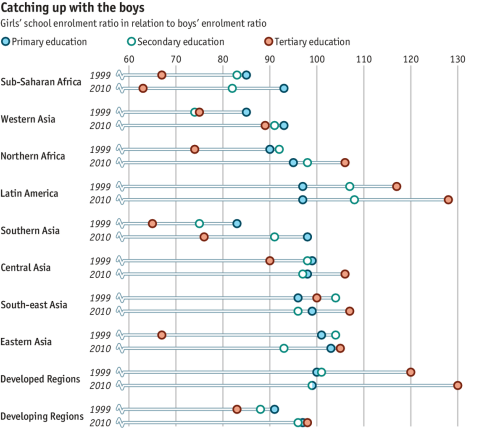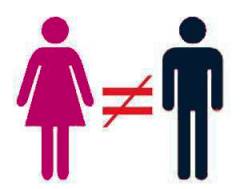At present we must look at an important issue in development economics- how to decrease the gap between the number of girls and boys being educated in poor countries.
Economists see decreasing sexual inequality in education as an imperative part of promoting development. The failure to educate girls limits economic development in the developing world by wasting human capital. Accordingly, the UN set itself the aim of eliminating gender disparity in education at all levels by 2015, as one of its Millennium Development Goals. Though places like China, Indonesia and Bangladesh look expected to achieve the target, Africa, in exacting, will not. For every 100 boys in secondary school on continent in 2010, there were only 82 girls. The most general response is to channel more money to girl's education. UN schemes finance school places for girls in 15 sub-Saharan countries. NGOs have got occupied also. Camfed, a charity, at the present pays for almost 100,000 girls to be educated in Ghana, Malawi, Tanzania, Zambia and Zimbabwe.

Look at recently-published UN statistics on gender inequality in education, one observes that the overall picture has enhanced dramatically over last decade, however development has not been even. Even though the developing world on average looks likely to hit the UN's gender-inequality goal, many parts of Africa are lagging behind. At the same time as progress is being made in sub-Saharan Africa in primary education, gender inequality is actually widening among older children. The ratio of girls enrolled in primary school rose from 85 to 93 per 100 boys between 1999 and 2010, while it fell from 83 to 82 and from 67 to 63 at secondary and tertiary levels.
In several places there has been little or no progress whatsoever. For example, the enrolment ratio in Chad and Central African Republic appears to be flat-lining at less than 70 girls per 100 boys. These two countries look soon to be overtaken by Afghanistan, up to currently the worst performing country in the world on this metric. There is too great variation within countries. The situation appears to be much poorer in rural areas in Africa, where getting to school takes longer and may be more dangerous. For example, in rural areas of Niger, UN estimates puts the number of girls per 100 boys at school as less as 41.
This is in contrast to dramatic enhancements in gender equality in schooling seen in the rest of world. South Asia that lagged behind sub-Saharan Africa in 1999 at the primary school level hit the UN's 2015 target in 2010. Still the Middle East, where traditional religious prejudices often prevent girls going to school, has made substantial growth. Only Afghanistan, Pakistan and Yemen currently have less than 90 girls per 100 boys at school, in difference to over 14 sub-Saharan African countries.
Up till now it is important to note that gender inequality is not the only problem in Africa. In several places there are not enough school places to go around for the boys alone. In Niger just 15 percent of both boys and girls were enrolled in secondary school last year. In the extremely poorest of African countries, just funding more school places for boys or girls might end up boosting equality as girls may stop having to participate with boys for few available spaces.
However other problems prevent girls going to school too. Some are kept away by religious qualms of their families. Others are essential as child labour to prop up household incomes while times are tough, due to the lack of developed insurance or saving systems in these countries. Moreover way, gender inequality in Africa is a complex problem and one which will need a number of different policy responses if the UN's goals are ever to be reached.
UNGEI works towards the elimination of barriers to learning, for example school fees and other education costs and for access to education in emergency situations. It advocates for early childhood education and development for children of poor families, literacy and the empowerment of young and women people.
She possibly will be the next president of her country, if only she could read or write.
For too many girls, the basic human right to education is denied. In countries across the world, long distances to school and social norms promoting gender inequality prevent girls from learning.

In reaction to this troubling reality, the United Nations Girls' Education Initiative (UNGEI), a partnership of organizations devoted to promoting girls education was launched in 2000 at the World Education Forum in Dakar by after that UN Secretary-General Kofi Annan.
UNICEF is proud to be the direct agency and secretariat for UNGEI. Together with its partners, UNICEF is working tough to transcend barriers to girl's education and narrow gender gap in primary and secondary education.
For instance, in Yemen, where poverty and high population development rates have contributed to high rates of illiteracy and gender inequality in education, UNGEI joined with the Ministry of Education and the private sector to create an advocacy campaign aimed at parents. The 'Let me Learn' initiative aims to raise awareness about the importance of girls' education and enlarge girl's enrolment during motivational billboards, posters and text messages in both urban and rural areas.
In Yemen and the remaining of the globe, UNGEI's work is possible through continued partnership and collaboration at global, regional and country levels.
Substantial improvement has been made. Girl's education is expanding across the world other than not fast enough.
With global help and support, UNICEF would continue working to remove barriers to learning, helping to make sure that girls have a voice and a chance for a bright and successful future.
Mutually, UNGEI and its partners can reverse the cruel realities of educational inequality, empowering girls to become tomorrow's future leaders.